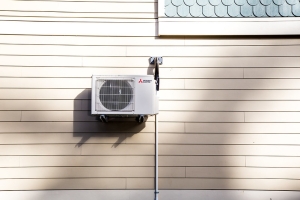Clean Energy Canada | Canada Green Buildings Strategy a positive, partial step forward for cleaner construction and lower energy bills
July 16, 2024

TORONTO — Ollie Sheldrick, program manager at Clean Energy Canada, made the following statement in response to the federal government’s Canada Green Buildings Strategy.
“Today’s launch of the federal government’s Canada Green Buildings Strategy shows a clear understanding of the key priorities needed to help affordability-constrained Canadians and our changing climate. In some areas, however, it also lacks an implementation plan to meet the moment.
“It’s encouraging to see a commitment to transitioning away from one-way air conditioners toward heat pumps as well as to phase out expensive and heavily polluting oil heating systems. But in both cases, the pace of change is too slow and clarity over how these efforts will be achieved is lacking in this strategy.
“In 2024, we should not be constructing any new buildings with oil heating in particular. It’s expensive to run and will leave homeowners rapidly stranded with out-of-date technology and an avoidable retrofit cost in the near future.
“The new Greener Homes Affordability Program is a much-needed replacement for the Greener Homes Grant, which was wrapped up at the beginning of the year, and will help many low-to-median-income households reap the benefits and savings of clean energy retrofits.
“It’s also exciting to see Canada join other leading countries by advancing home energy labeling, which helps households understand the energy costs and carbon footprint of a home they are buying. Getting this implemented as soon as possible is key, as well as expanding the rollout of energy labels to rental units. Both home energy labeling and the Greener Homes Affordability Program will also provide job opportunities for green building workers, many of whom faced an uncertain future after the previous Greener Homes Grant program closed.
“Finally, we welcome the strategy’s Buy Clean chapter. Buy Clean—the setting of government procurement policies to incentivise and require the use of low-carbon building materials—is an approach that, if wielded fully, would maximize the government’s return on its industrial decarbonization investments, level the playing field with the U.S., and support Canadian jobs.
“The chapter builds on the requirements for federal departments and crown corporations announced as part of the Greening Government Strategy to date. The commitment to apply measures to disclose and reduce embodied carbon in future infrastructure spending programs is a particularly important step that will expand the impact of Buy Clean, and is complemented by commitments to fund pilot projects and expand the low-carbon materials database to increase awareness of clean material options. But while the chapter combines a number of positive existing and new measures, clearer and more ambitious actions would have seen further opportunities unlocked for Canadian manufacturers and builders and better aligned us with Buy Clean in the U.S.
“This government plans to build million homes by 2030 and retrofit millions more. With the right policies in place, we can build these homes with a smaller carbon footprint, more Canadian materials, and ultimately lower energy bills for the people who live in them. The Canada Green Buildings Strategy is a positive—if incomplete—step toward this future.”
KEY FACTS
- Fuel oil is the least efficient, most expensive, and most polluting source of building heat in Canada. Efficiency Canada estimates that households across Canada could save over $4,000 per year by heating with a cold climate heat source instead of fuel oil.
- In a cross-Canada analysis, the Canadian Climate Institute found that in most cases, heat pumps provide cheaper heating and cooling than gas and air conditioning.
- Heat pump sales overtook gas furnace sales in the U.S. in 2022, meaning heat pumps are already the preferred new heating source in U.S. buildings.
- By procuring construction products with a lower carbon footprint, governments can effectively support a sizable market for clean building products—an approach known as Buy Clean. By introducing an ambitious and truly national Buy Clean policy that spans all levels of government, Canada could avoid up to 4 million tonnes of emissions by 2030 while supporting Canadian producers and workers.
- Canada’s Housing Plan aims to build million new homes by 2030. That construction alone could lock in 728 megatonnes of emissions (more than a year’s worth of Canada’s total emissions). The average Canadian home construction embodied 188 tonnes of emissions in 2018, over a third of which were imported emissions (primarily from China, the U.S., and India).
- Seventy-eight percent of Canadians believe housing must be built in a way that minimizes pollution, according to an Abacus Data poll conducted for the Task Force for Housing and Climate.
RESOURCES
Report | Money Talks
Report | Building Success: Implementing Effective Buy Clean Policies